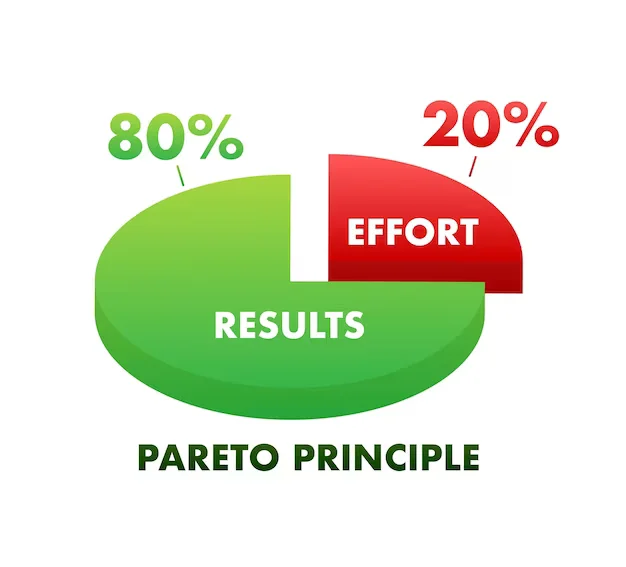80/20 Pareto Rule: How To Increase Your Productivity by Doing Less

The 80 20 rule, also known as the Pareto principle, is a fundamental productivity aphorism that explains how 80% of your outcome results from 20% of your input in all spheres of life, highlighting high impact tasks and important tasks.
It also agrees with the Pareto principle that less is more, emphasizing the need to identify the 20% in work and life responsible for your most significant impact and focus on those high priority tasks and impactful tasks.
Unfortunately, very few individuals know how to maximize their productivity by focusing on high priority tasks and impactful tasks using the Pareto analysis and productivity tips.
Whether you want to boost your employee productivity or improve your work-life balance, this blog post will enlighten you on 80 20 Pareto rule, how to increase your productivity by doing less, focusing on high priority and impactful tasks.
Sounds antithetical? Let's get right into it!
What is the 80/20 Rule?
The 80 20 rule is generally known as the Pareto principle. It states that 20% of input is responsible for 80% of work and everyday life output, highlighting the importance of identifying high impact tasks.
The Pareto principle is named after the late 19th century/early 20th-century Italian economist and sociologist Vilfredo Pareto, who made significant observations about wealth distribution.
Pareto observed in Italy that only 20% of the population controlled the vast 80% of wealth, a concept now visualized using a Pareto chart. His critical observation evolved to be applied in business, projects, and other spheres of life, emphasizing strategies for high priority tasks.
The 80 20 rule is valid and still applies today, providing significant impact in various fields including business and personal productivity.
Here is a little example to demonstrate:
In your work life: The few hours of the day when you feel highly energized and inspired account for the most productive work, aligning with Pareto principle states about high impact tasks. So, your most effective 20% of effort produces 80% of your outcome, a clear example of the Pareto principle in action.
In sales: 20% of clients are responsible for boosting 80% of company sales, highlighting high impact tasks and the 80 20 rule.
In Business: The most equity in several establishments is owned by only 20% of the top investors, who become significant shareholders, demonstrating the Pareto principle.
How does the 80/20 rule work?

The 80/20 rule emphasizes prioritization, helping you maximize productivity by focusing on tasks that make a significant impact while reducing time constraints and efforts on other tasks.
Most people seem busy around the clock with their to-do list and other tasks, yet achieve so little due to time constraints and not focusing on tasks that matter and have a significant impact.
The reason is that most people spend their time on low-value, time-consuming tasks rather than on those that maximize productivity and have a significant impact on their outcomes. With the right knowledge of the 80/20 rule, you can shift your focus to the tasks that truly matter and optimize how your time is spent.
Additionally, the 80/20 rule charges you to focus on complex tasks that maximize productivity, determine outcomes, and make a significant impact on your overall efforts.
For instance, if you are an entrepreneur, you could maximize productivity and determine your outcomes by applying the 80/20 rule and subscribing to online paystub generators.
You can use online invoices to replace paper and go paperless with your paystubs. The more time you spend on fewer, more significant tasks, the more you maximize productivity and reduce time constraints on less important tasks.
How can you effectively use the 80/20 rule to increase your productivity
The ultimate use of the 80/20 rule is to maximize productivity by focusing on tasks that have the most impact and minimizing less impactful efforts. Doing less means focusing your efforts on critical tasks that maximize productivity and have the most significant impact on your outcomes.
It also means cutting out less impactful functions, reducing time constraints, and focusing on tasks that maximize productivity and have a significant impact on your outcomes.
Here are a few steps you can take and apply to your life and work to effectively put the 80/20 rule to use and begin achieving more by doing less:
-
Develop clarity and direction toward your goals with a deep dive into what truly matters
-
Divide your tasks, goals, and abilities into two groups of majors and minors using examples of the Pareto principle
-
Cut down opportunities for procrastination by doing instead of thinking and planning for most results
-
Keep track of your time and results
Now that you know how to apply the Pareto principle, consider this rule's benefits by examining real-world examples and understanding how it matters in your daily life and work.
What are the benefits of applying the 80/20 rule in work and life?

Here is what you stand to gain by applying the Pareto principle:
-
Increased productivity at work and in life
-
Effective thought leader at work
-
Improved self-confidence due to high achievements
-
Efficient use of resources
-
It improves your problem-solving skills
-
Fine-tunes your decision-making prowess, etc.
Final Thought
The 80/20 rule has evolved from a workplace principle to becoming a life hack for several productivity enthusiasts. Interestingly, this principle not only applies to work but to everyday life. Therefore, you can apply it to stay focused on your goals and eliminate energy drainers to live a successful and impactful life.

